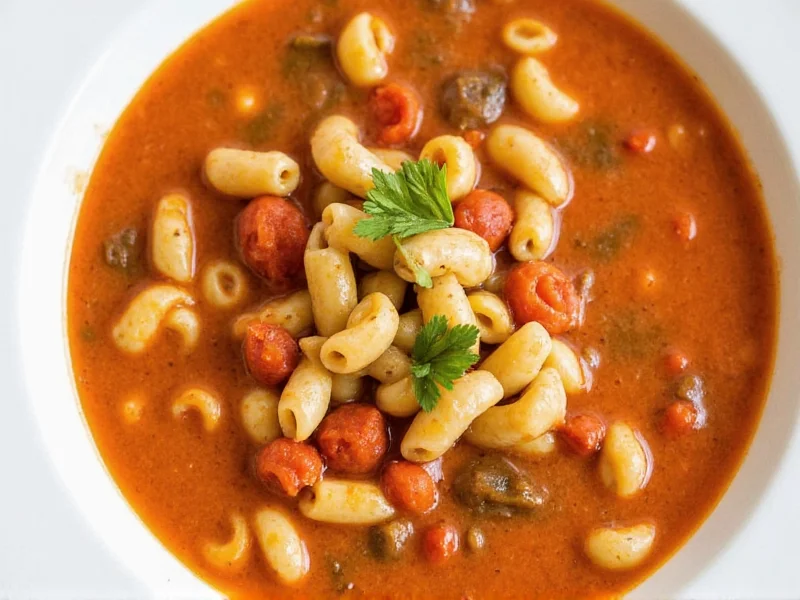The Heart of Italian Comfort Food
Pasta fagioli, often called “pasta fazool” in Italian-American communities, represents cucina povera (“poor kitchen”)—the art of transforming humble ingredients into deeply satisfying meals. This rustic soup has nourished Italian families for centuries, with regional variations across the country. While some versions include pancetta or guanciale, the true Roman original remains vegetarian, relying on soffritto (onion, carrot, celery) and garlic for flavor depth.
Essential Ingredients Breakdown
Understanding each component ensures your authentic pasta fagioli soup recipe achieves balanced flavors:
| Ingredient | Why It Matters | Substitution Options |
|---|---|---|
| Cannellini beans | Creamy texture, mild flavor that absorbs broth | Great Northern beans (avoid kidney beans) |
| Ditalini pasta | Perfect size for soup—small tubes hold broth | Small shells, elbow macaroni, or orzo |
| Pelati tomatoes | Sweet, smooth tomato base without acidity | Crushed San Marzano tomatoes |
| Parmesan rind | Adds umami depth (traditional secret) | 1 tsp nutritional yeast (vegetarian option) |
Step-by-Step Cooking Process
Follow these steps for the best pasta fagioli soup with cannellini beans that develops complex flavors:
- Soak beans overnight (or use quick-soak method: boil 2 minutes, rest 1 hour)
- Sauté soffritto in olive oil until translucent (10 minutes on medium-low)
- Add garlic and rosemary, cook 1 minute until fragrant
- Stir in tomatoes and cook 5 minutes to deepen flavor
- Add soaked beans and broth, simmer 45-60 minutes until tender
- Partially mash beans with potato masher for creamy texture
- Cook pasta directly in soup (5-7 minutes) to absorb flavors
- Finish with fresh parsley and extra virgin olive oil
Pro Tips for Authentic Results
Master the classic pasta e fagioli recipe with these professional techniques:
- Bean consistency is crucial—aim for 70% intact beans, 30% mashed for ideal thickness
- Add pasta last to prevent overcooking; soup thickens as it rests
- Use reserved bean cooking liquid instead of water for richer broth
- Rest overnight—flavors deepen significantly when reheated
- Adjust thickness with hot water if too dense after refrigeration
Variations Across Italy
Explore regional pasta fagioli soup variations while maintaining authenticity:
- Roman style: Vegetarian, uses ditalini, minimal tomato
- Southern Italian: Often includes pancetta and more tomato
- Lazio region: Features wild fennel instead of rosemary
- Italian-American: Typically heartier with more pasta and tomato
Serving Tradition and Pairings
Serve traditional Italian pasta fagioli properly for the complete experience:
- Bowl temperature—preheat bowls with hot water for restaurant-quality service
- Garnish simply—fresh parsley, cracked black pepper, and high-quality olive oil
- Accompaniments—crusty bread for dipping, not side salads
- Wine pairing—medium-bodied red like Chianti or Montepulciano
- Timing—traditionally served as primo (first course), not main dish
Storage and Reheating Guidelines
Pasta fagioli improves with time but requires proper handling:
- Refrigeration—store up to 5 days in airtight container (pasta continues absorbing liquid)
- Freezing—best without pasta (add fresh when reheating); freeze up to 3 months
- Reheating—gently warm on stove with splash of broth or water to restore consistency
- Reviving leftovers—stir in 1 tsp tomato paste while reheating for flavor boost
Frequently Asked Questions
Can I make pasta fagioli soup vegetarian?
Yes, authentic Roman pasta fagioli is naturally vegetarian. Skip pancetta and use vegetable broth. For umami depth, add a Parmesan rind while simmering (remove before serving) or use 1 tsp nutritional yeast.
Why is my pasta fagioli too thick?
The soup naturally thickens as it rests and the pasta absorbs liquid. Reheat with additional broth or hot water, 1/4 cup at a time, until reaching your preferred consistency. Remember authentic pasta fagioli should be thick enough to coat a spoon but still soupy.
What’s the best pasta for fagioli soup?
Ditalini (small tubes) is traditional, but other small shapes work well. Avoid large pasta that dominates the soup. Cook pasta directly in the broth for maximum flavor absorption, and remember it will continue softening as the soup sits. For meal prep, cook pasta separately and add when serving.
How do I get the creamy texture without dairy?
The creaminess comes from partially mashing the beans. After simmering, use a potato masher to crush about one-third of the beans directly in the pot. This releases starches that thicken the broth naturally. Never add cream—authentic versions rely on bean starch for texture.
Can I use canned beans instead of dried?
While dried beans yield superior flavor and texture, you can substitute canned beans in a pinch. Use 3 cans (15oz each) of cannellini beans, rinsed well. Reduce cooking time to 20 minutes after adding tomatoes. Add 1 cup reserved bean liquid for better consistency. Note: canned beans may break down more easily when mashed.











 浙公网安备
33010002000092号
浙公网安备
33010002000092号 浙B2-20120091-4
浙B2-20120091-4